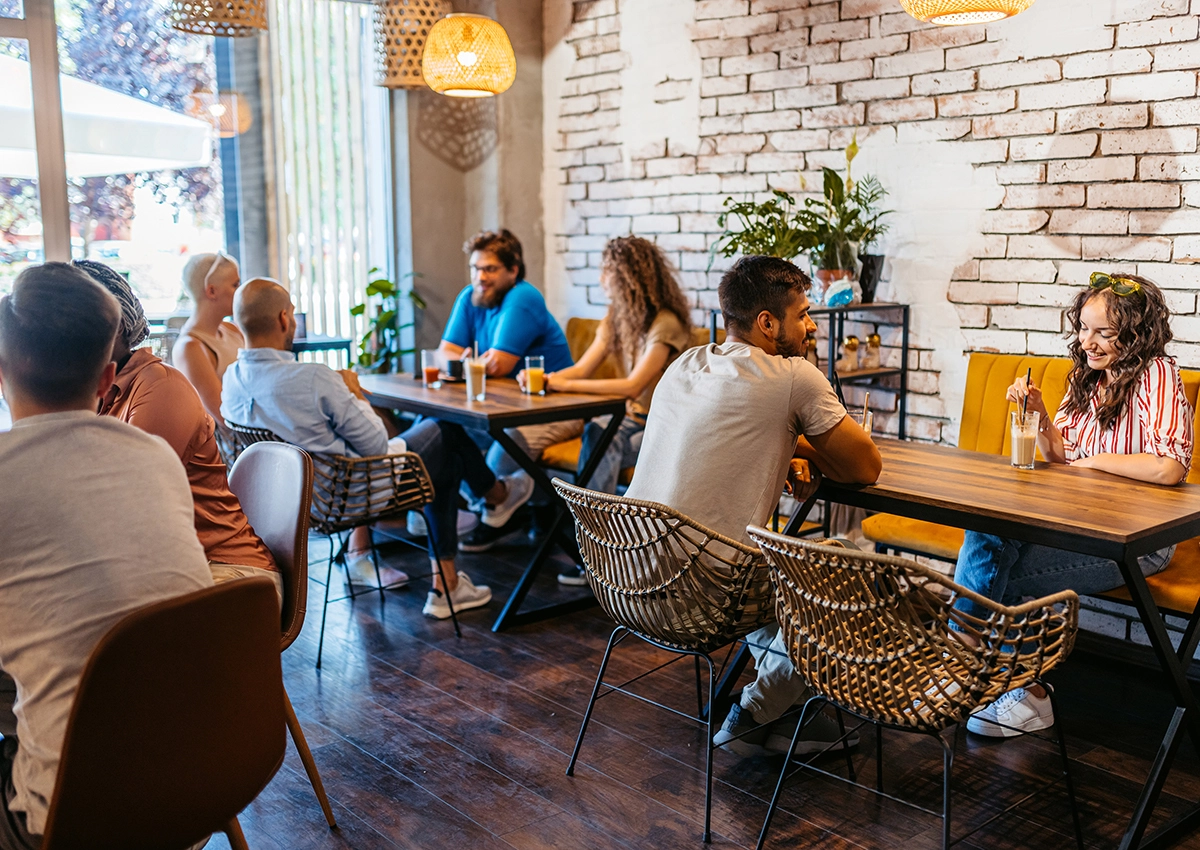The pressure to adopt new technology in your restaurant is everywhere. From server robots to ordering kiosks in fast food establishments, it seems like there’s always a new gimmick trying to get your attention.
But data shows that it’s more than just about the flashy toys. In a study by the Wharton School, researchers found that using tabletop technology can improve sales by 9.74% and productivity by 10.77%. Beyond that, it can also increase table turnover by nearly 17%!
As a restaurateur, you know that these metrics are more than just numbers. They’re some of the leading factors that impact your revenue.
While implementing tablets in your eatery can significantly affect your bottom line, numbers alone don’t tell the story. Depending on how you use them, they could revolutionize how you interact with your customers.
We’ll cover:
- Boosting revenue
- Direct impacts on table turnover
- Operational efficiency and cost reduction
- A new era of customer interaction
- Revenue streams beyond food and beverage
- Environmental impact and sustainability
- The psychology of digital ordering
- Behind the scenes: impact on kitchen and staff workflow
- The bigger picture: long-term business growth and customer loyalty
Let’s take a look!
Boosting revenue: a closer look
The discussion around restaurant tablets centers on two different modes of deployment: customer-driven and server-driven tablets.
In the first model, customers have access to kiosks or tablets at the table and can place orders and payout at their convenience. In the second model, servers carry tablets to expedite the ordering and payment process tableside.
While these are fundamentally different uses of tablets, they have one thing in common: they boost revenue. It’s not just about one aspect of the customer journey either. The use of technology expedites each part of their process.
High-quality menu imagery per dish
In the age of digital dining, restaurant tablets offer a tantalizing upgrade to traditional menus with their ability to showcase high-quality imagery for each dish. Unlike conventional menus that typically feature only a handful of select images, online menus allow patrons to feast their eyes on a captivating image for every culinary creation on offer. These visuals not only enhance the dining experience but also present a golden opportunity for guests to discover and crave appetizers, desserts, or beverages they might have overlooked otherwise. With each vivid image beckoning diners to indulge, restaurant tablets are revolutionizing the way we choose and savor our meals.
Dynamic pricing strategies
Most restaurants and bars use digital menus because of their flexibility. They’re easy to update and offer advantages over traditional signage due to your ability to customize. But at the table, it’s still more common to see traditional menus. We think this is a missed opportunity!
Restaurant tablets and kiosks allow for dynamic pricing that changes based on your needs. You can schedule updates for happy hour or special events to capitalize on the boost in traffic. If your chef is running an in-demand special, you can easily adjust the price or remove it from the menu when it’s sold out.
Leveraging data for menu optimization
Tablet-based restaurant POS systems like CAKE gather data across your business. You’ll have real-time access to your restaurant’s performance in the dining room and bar, pickup orders, and curbside. Using this data, you can make informed decisions about when to make changes to your menu for maximum revenue.
Dynamic pricing strategies are a hot topic in the industry. Adjusting prices based on demand, seasonality, and customer flow is one way to leverage your data. Incentivizing your customers to visit during off-times for lower prices isn’t anything new. Digital menus, though, make these adjustments simple with the data to back them up!
Direct impacts on table turnover
Table turnover is a revenue driver that’s impacted by implementing tableside ordering. Whether you’re using kiosks or servers in your restaurant, the immediacy of tablet-based ordering makes a difference.
Ideally, you’re turning tables at least 2 to 3 times during service. Factors like the type of food you serve, customer behavior, and server efficiency all impact how quickly your customers move on. You may not be able to affect some of them, but using tablets in your establishment gives you an edge.
Immediate order placement
Usually, your customers give their orders to a server that inputs them into a central POS terminal for fulfillment. Several points along this path can bottleneck and cause delays. Servers may be delayed, there might be a backup at the POS, or an order may get lost in the shuffle.
Tablet-based ordering systems transmit orders directly from the handheld POS to the kitchen or bar screen for immediate fulfillment. Restaurants with kiosks put the power directly into the customer’s hands. Once they’re seated, they can place orders when ready that go directly to the kitchen. They can take their time or jump right in the queue, customizing their experience!
Real-time table management
Restaurant tablets provide real-time data about table turnover, allowing your staff to adjust seating easily to maximize efficiency. As guests check out on a tablet payment system, your systems update showing the table status.
It should consider the party’s size and any special requests to help balance the workload for your servers. You can also manage your waitlist and reservations more effectively so that all guests are seated in a reasonable time frame.
Quick and easy payment processing
When your patrons are ready to pay at the end of their experience, they can use the tablet or their own device to complete the transaction. Not only does this speed up the process, it can lead to higher tips for your staff and faster table turnover. Customers don’t feel rushed, but when they’re ready to leave, they don’t have to wait.
Operational efficiency and cost reduction
Tablets and cloud-based POS systems can also significantly impact your daily operations. Data from your restaurant’s daily business can give you important insights into your costs and overall efficiency.
Inventory management integration
Creating your digital menu in your tablet-based POS system makes it possible to track food usage more accurately. For instance, CAKE easily integrates with Orca, a leading inventory management system. This allows you to input recipes and ingredients and use historical data to create orders and budgets for future use.
Labor management
Tablets increase the efficiency of your servers by expediting many of their customer interactions. Instead of taking orders, they can give the customer experience piece of their jobs more attention. Kiosks may even reduce the number of staff you need on hand while not compromising the dining experience.
CAKE integrates seamlessly with several staffing and payroll apps they’re needed most.
Predictive analytics for table allocation
Predictive algorithms in your tablet-based POS system allow for more equitable table distribution during peak times. It can estimate table turnover rates and ensure servers aren’t overloaded during service.
Seasonal and event-based menu adaptations
Changing your menu and prices based on special events and seasons is simple with a tablet-based digital menu. Your customers can instantly see unique offerings or limited offerings without the need for changes in a physical menu.
A new era of customer interaction
In your restaurant, your servers likely have the most customer interaction. Their job isn’t just to ensure a positive experience. It often includes answering diners’ questions and providing details about the menu. Enhancing the customer experience through technology allows you to connect them to your brand throughout their visit.
Enhanced dining experience
One of the most exciting features of a digital menu is your ability to use it to tell a story. Essentially, it gives you access to interactive features that replace the server’s sourcing stories and interpretations of the chef’s dishes. You could feature imagery and descriptions that tell a story or bring your chef out of the kitchen to explain tasting notes for certain dishes.
Language and accessibility options
Interactive menus offer your diners language and accessibility options that enrich their experience. Instead of guessing based on pictures, you can include multi-language menus for your patron’s convenience. You can also include accessibility features like read-aloud menus and screen reader-friendly headings.
Revenue streams beyond food and beverage
In a traditional restaurant model, your revenue streams are limited to food and beverage. You may bottle a secret sauce or have shirts and stickers, but there’s not a lot of room for external revenue drivers. Tablets bring new possibilities to the table!
Merchandise and gift card sales
If you have merchandise for your eatery, you can feature it as part of your digital menu. Diners can easily add any branded items you may have for sale to their bill instead of making a second stop on the way out the door. Tees, mugs, pint glasses, and sunnies are popular merch items that excite your customers.
Gift cards are another popular item that you can feature on your menu. It’s easy to add them when they’re already on the menu!
Environmental impact and sustainability
It may not be the first thing that comes to mind when transitioning your establishment to a digital-first POS system. But you can’t ignore that a traditional system produces a lot of waste! Tablets can help you reduce your carbon footprint and increase customer engagement at the same time.
Reducing paper waste
Nationally, restaurants generate over 1.5 billion pounds of paper waste yearly, just in receipts. Factor in paper menus and other signage, and you’re looking at a significant impact on both your bottom line and the environment.
Using tablets in your restaurant removes your need for paper receipts and menus, effectively removing you from the waste stream! Simply allow your customers to have receipts emailed or texted to them and eliminate a check getting lost again.
Energy efficiency and sustainability
When you’re purchasing the hardware you need to run your tablet-based POS system, you have an opportunity. Choosing energy-efficient models for your staff is the economical choice. Some systems are flexible between Android and Apple, but Apple products have the highest sustainability rating.
If you purchase CAKE’s hardware bundle, you’ll get customized iPads for tableside service. They’re equipped with a bombproof design and can take any payment method.
The psychology of digital ordering
Digital ordering interfaces allow you to include lots of information about the items on your menu. Instead of simply seeing the text, your patrons will likely find images and videos enticing. Appealing to their eyes first, a media-rich digital menu is a feast waiting to be ordered!
Impulse purchases and order customization
Ordering from a traditional menu usually involves frantic scanning and one order before the server takes all the menus from the table. The interaction is stressful for some, and it’s not usually when impulse purchases happen.
Especially for restaurant owners using kiosks, digital menus open the door for endless customization and impulse purchases. Most POS systems will suggest modifiers and add-ons based on the customer’s input. This feature enhances the customer experience by putting them in the driver’s seat. When you look at the data, you’ll see another enhancement to your business as well: your bottom line!
Behind the scenes: impact on kitchen and staff workflow
Tablets don’t just have an impact on your FOH operations and management. They can impact your kitchen and back-of-house staff, too. They can streamline workflows and help make your kitchen run like a well-oiled machine.
Kitchen efficiency and order accuracy
A typical kitchen is a blizzard of order slips coming in and going out. While seasoned cooks handle the pressures of the kitchen well, mistakes are inevitable. Tablets in the kitchen are one way to reduce errors and increase your kitchen’s efficiency. Orders go directly from tableside to the kitchen, splitting between stations and reducing confusion.
Staff training and adaptation
Getting your team on board with a new system is the most critical part of implementing a tablet ordering system in your restaurant. The amount of time it takes to onboard them to the new system varies depending on how complex your setup is. It could take one three-hour session or two weeks to bring your staff up to speed.
The best method for training your staff includes time to play. Let them spend time with the system before roll-out so they’re familiar with it and can bring questions to training sessions. Identify some key staff members who can serve as experts on shift if issues arise. When the problems occur, let your employees be part of the solution.
Once they’ve acclimated to the new system, you’ll be amazed at how quickly the benefits show up!
The bigger picture: long-term business growth and customer loyalty
Implementing a tablet ordering system in your restaurant is an investment in the future. You’ll see some benefits immediately, but the long-term effects on your business will surprise you.
Building customer loyalty through technology
Developing a relationship with your customers is about more than just welcoming them into your establishment. As you learn more about them, you can begin to offer incentives they want and reward them for their loyalty. Customer reward programs allow you to track what your regular patrons order, keep birthdays and anniversaries on file, and help you provide more personalized service.
When your customers feel valued, they’re more likely to feel connected to your business and keep coming back.
Long-term business growth and ROI
Growth is essential to maintain the viability of your business in the competitive restaurant industry. Putting tablets in the hands of your servers makes them ambassadors for your brand and empowers them to take ownership of the customer experience. Further, the data you gather from a cloud-based POS allows you to make strategic decisions about everything from your menu to seasonal specials.
Getting a good return on your investment is top of mind for most business owners. Putting tablets in your restaurant is almost a guarantee. They give you the tools to be responsive and nimble, and in the food industry, that’s priceless.
Analyze the long-term financial benefits and ROI of implementing tablet systems.
Conclusion
Restaurants are jumping onto the technology bandwagon in record numbers, and for good reason. Getting rid of expensive and dated legacy systems in favor of cloud-based tablets is a game changer for your business. Give servers the support they need to increase your restaurant’s efficiency and customer loyalty with technology.
CAKE’s restaurant POS is designed to help your food business thrive. A rich feature set and seamless integrations with your other business apps make it the smart choice for your business.







